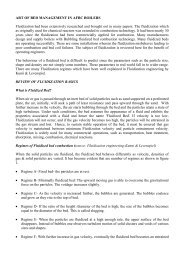Article on gauge glass level fluctuation
You also want an ePaper? Increase the reach of your titles
YUMPU automatically turns print PDFs into web optimized ePapers that Google loves.
IS YOUR GAUGE GLASS FAILING OFTEN?<br />
By K.K.PARTHIBAN, Boiler C<strong>on</strong>sultant<br />
Venus Energy Audit System<br />
Email ID:parthi2006@gmail.com / venus.energy@gmail.com<br />
A customer had been facing <strong>gauge</strong> <strong>glass</strong> failures ever since the boiler was commissi<strong>on</strong>ed. He asked me<br />
how could this happen. He reported that water keeps <strong>on</strong> trickling down the <strong>gauge</strong> <strong>glass</strong> from steam<br />
side. This happens in both side water <strong>level</strong> <strong>gauge</strong>s.<br />
There can be two reas<strong>on</strong>s for this. One is Foaming of boiler water. Another reas<strong>on</strong> can be the uninsulated<br />
pipes c<strong>on</strong>necting the <strong>level</strong> <strong>gauge</strong>. Insulati<strong>on</strong> of the pipes can be easily attended to. Foaming<br />
leads to dancing of water <strong>level</strong> <strong>gauge</strong>. You may observe water fluctuati<strong>on</strong>s to an extent of 50 mm.<br />
Foaming can occur due to several reas<strong>on</strong>s. Foaming not <strong>on</strong>ly affects the water <strong>level</strong> but also steam<br />
purity.<br />
Foaming - This is the formati<strong>on</strong> of foam in the space between the water surface and the steam offtake.<br />
Foam <strong>on</strong> a <strong>glass</strong> of beer sits <strong>on</strong> top of the liquid, and the liquid / foam interface is clearly<br />
defined. In a boiling liquid, the liquid surface is indistinct, varying from a few small steam bubbles at<br />
the bottom of the vessel, to many large steam bubbles at the top.<br />
The following are indicati<strong>on</strong>s and c<strong>on</strong>sequences of foaming:<br />
• Water will trickle down from the steam c<strong>on</strong>necti<strong>on</strong> of the <strong>gauge</strong> <strong>glass</strong>; this makes it difficult to<br />
accurately determine the water <strong>level</strong>. It leads to frequent <strong>gauge</strong> <strong>glass</strong> failure.<br />
• Level probes, floats and differential pressure cells have difficulty in accurately determining<br />
water <strong>level</strong>.<br />
• When low water <strong>level</strong> happens, the boiler will trip unnecessarily.<br />
• Phosphate <strong>level</strong>s are unc<strong>on</strong>trollable. Phosphate hide out is experienced. All of a sudden you<br />
will find phosphate <strong>level</strong> going up even after stopping chemical dosage.<br />
• Smaller drum sizes may lead to permanent foaming. At low loads the faming may not be<br />
experienced. The trend is towards smaller boilers for a given steaming rate. Smaller boilers<br />
have less water surface area, so the rate at which steam is released per square metre of water<br />
area is increased. This means that the agitati<strong>on</strong> at the surface is greater. It follows then that<br />
smaller boilers are more pr<strong>on</strong>e to foaming.<br />
• TDS <strong>level</strong> - As the boiler water TDS increases, the steam bubbles become more stable, and are<br />
more reluctant to burst and separate.<br />
• Oil / Grease c<strong>on</strong>taminated water will lead to high <strong>level</strong> of foaming.<br />
REMEDIAL MEASURES<br />
• Look for sources of suspended matter ingress. In can happen due to pre-boiler system corrosi<strong>on</strong>. In<br />
many plants pH correcti<strong>on</strong> is not being d<strong>on</strong>e at DM / RO plant outlet. This leads to corrosi<strong>on</strong> of<br />
piping / tank and thus boiler feedwater will be c<strong>on</strong>taminated with ir<strong>on</strong> powder. This accumulates<br />
in steam drum over the steam – water interface. Go for lining of the tanks. Raise pH at water<br />
treatment plant outlet itself.<br />
• There can be secti<strong>on</strong>s of steam user equipment which is being started / stopped often. During every<br />
start, this process equipment sends its entire corrosi<strong>on</strong> product to boiler al<strong>on</strong>g with c<strong>on</strong>densate.<br />
Look for steam capping / Deaerated hot water circulati<strong>on</strong> arrangement to preserve the process<br />
equipment from corrosi<strong>on</strong>.<br />
• The boiler itself foams if not preserved properly during outages.
• Turbidity increase during rainy seas<strong>on</strong>, if not treated properly can get into boiler water leading to<br />
foaming.<br />
• D<strong>on</strong>’t dose excess chemicals. D<strong>on</strong>’t simply dose chemicals as per chemical vendor advice.<br />
Understand the purpose and regulate the chemical dosage.<br />
• In some plants chemical dosing is d<strong>on</strong>e without c<strong>on</strong>tinuous chemical dosing system.<br />
• C<strong>on</strong>densate pH c<strong>on</strong>trol can be adopted by use of volatile chemical dosage. Thus c<strong>on</strong>densate line<br />
corrosi<strong>on</strong> can be avoided.<br />
• Anti-foaming agents may be added to the boiler water. These operate by breaking down the foam<br />
bubbles. However, these agents are not effective when treating foams caused by suspended solids.

















